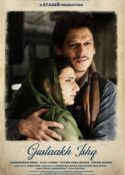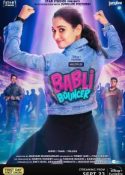 Subhash K Jha revisits Sanjay Leela Bhansali’s Hum… Dil De Chuke SanamHum… Dil De Chuke Sanam. Thereafter, my life as a cineaste underwent a complete change. Don’t get me wrong. I am not saying my friend Sanjay has made the best film ever. Or perhaps I AM saying that. And don’t let the “friend” before Sanjay’s name distort the truth. I became friends with the director only after he made Hum Dil what-have-you.
Subhash K Jha revisits Sanjay Leela Bhansali’s Hum… Dil De Chuke SanamHum… Dil De Chuke Sanam. Thereafter, my life as a cineaste underwent a complete change. Don’t get me wrong. I am not saying my friend Sanjay has made the best film ever. Or perhaps I AM saying that. And don’t let the “friend” before Sanjay’s name distort the truth. I became friends with the director only after he made Hum Dil what-have-you.
I still remember that morning after the devastating experience. Before Ho-ho-hum-dil-de-chuke-sanam, all I knew about Sanjay was through Khamoshi: The Musical, not to be confused with Khamoshi: The Super-Musical that Asit Sen had made thirty years earlier. I expected to encounter an arrogant, impetuous director completely conscious of his genius as a director. And I was prepared for it. After all, Sanjay was the most romantically enthused and sensitive filmmaker since Guru Dutt and Bimal Roy—and let’s not beat around the ‘blush’ about such immodest evaluations.
On that morning, after I saw Hum… Dil De Chuke Sanam, Sanjay surprised me. The first thing he said to me after I introduced myself was, “If you’re a fan of Lataji, I am double her fan.”
That’s how our friendship started. Two Lata bhakts mulling and squabbling over her melodies, regretting why the Nightingale didn’t hum in Dil De Chuke Sanam. Over the weeks that followed, I lived every moment of Sanjay’s agony and ecstasy as reports of not-doing-well/doing-well/doing-so-so/doing-fine poured in from all parts of the world. Neither Sanjay nor I could understand how his film could be anything but a revolutionary success.

Absolutely flawless and foolproof, there is a melodious methodology motivating every rhythm and gesture in Sanjay’s neo-classic. Sure, Khamoshi was also a great work of art with emotions that stirred you to the bottom of your soul. But Hum Dil… is something more, something indescribably exquisite and achingly beautiful.
You know that feeling you get when you listen to Lataji singing ‘Hai tere saath meri wafaa main nahin to kya’? Does that feeling have a name? No? Then, how do you define the sparkling spray of sensuous emotions that Sanjay brings to life in Hum Dil? From the opening montage of Aishwarya Rai chasing a cart full of kite-flying revellers through the deserts of Rajasthan, accompanied by the sounds of Shankar Mahadevan’s ‘Man Mohini’, you are hooked, completely spellbound and enslaved to the cadences of the nubile narration.
Cinematographer Anil Mehta has filmed Sanjay’s passion-play with a sumptuous splendour that overpowers and subjugates our senses. Indeed Hum… Dil De Chuke Sanam is like a seven-course banquet where the dishes are so light in the tummy you never feel the unbearable heaviness of the yummy –Raj. It comes as a shock to know that Mehta won’t be shooting Sanjay’s Devdas. It’s Binod Pradhan who will do Sanjay’s next romantic opus.
But can Devdas be as enchanting and fulfilling as Hum… Dil De Chuke Sanam? I hope and pray it is. But a film like Hum Dil isn’t made. It just happens. “You’re right,” sighs Sanjay after collecting his hundredth award for the most romantic film of the last millennium (yes, yes, I know the Guru Dutt cinephiles are affronted, but what to do yaar when hum dil de chuke sanam?). “ Hum… Dil De Chuke Sanam just happened.”
I may be over-reacting. But I sincerely believe the work’s greatness has been underestimated by our esteemed critics. In fact, the sum total of the work is far greater than its parts. Because what Hum Dil tells us at the last is , “love’s not about conquering but concurring.” You may love and lose. But the loss subsumes a wealth of triumph in terms that neither money nor any earthly power can control.
There’s an arcadian innocence at the centre of the tale. The girl Nandini (Aishwarya Rai) is so pampered and protected from the outside world of corruption and heartbreak she thinks a kiss can cause pregnancy. ‘Aise thoda hi na hota hai’, Salman Khan chides her gently with a shy smile that is completely free of leery guile.
No actor should be bigger than the film. The trouble with making a huge film with big stars is, the stars’ images end up dominating the film’s other qualities. This didn’t happen in Hum… Dil De Chuke Sanam. Not for a second were we looking at Aishwarya Rai, Salman Khan, and Ajay Devgan. Or for that matter, Vikram Gokhale, Smita Jaykar, or Sanjay’s all-time favourite screen performer, Helen Aunty. Every actor, even in the minutest role, filled the frames with a happy and hectic conviction.
On most occasions when a director adopts the epic canvas subconsciously, unconsciously, or consciously, he shows the characters as casualties of the mammoth surroundings that accommodate the characters. This is as true of David Lean’s masterly desert epic Lawrence Of Arabia as it is of Abbas-Mustan’s Soldier, which situated its terrible battles in the sandscape.
In Hum Dil… all the battles are fought within the human heart. Whether it’s the haveli with its rhythmic riot of rainbowy shades or the brilliantly sombre granite-and-silt smoothness of Budapest— the striking landscape perfectly and effortlessly complements the majesty of the human heart.
The story is inspired by a folk tale about a young man from the outside who joins a joint family, falls in love with the girl of the family where he’s come to be educated. When her father gets to know the truth he exercizes his rights as a guru and demands that the lover-boy never look at his daughter for as long as he lives. Like an obedient shishya, the man makes the promise to his guru. Decades pass. At the ripe old age of 80, the now-blind lover finally goes before his beloved. “I’ve kept my promise to your father.”
Sanjay converts the folk tale into a modern-day fantasia-romance where Muslin dupattas rub shoulders with the baroque interiors of symphony chambers where the lovers’ pleas echo with anguished resonance. There are images in Hum… Dil De Chuke Sanam that will remain alive in our hearts for as long as cinema lives. When Salman leaves the haveli, the girl crashes into the chandelier as she rushes out to look at her man for the last time. The chandelier overturns, and her dupatta catches fire.
As Anil Mehta’s camera trails after Aishwarya with her dupatta on fire, our hearts leap into flaming circles of protest at the sheer injustice of separating the lovers. From this point, when we are one with Salman and Aishwarya, the narrative has to wean us away from love’s tangles to a complete faith in the sanctity and purity of the marital vows when the husband, Ajay Devgan’s monstrous nobility, becomes a metaphor for selfless love. How can a man who takes his wife in search of her lover, go unrewarded?

It’s to Sanjay’s credit that Ajay Devgan’s character never appears wimpish even when he weeps in drunken heartbreak under that fateful bridge in Budapest (posing as “Italy” in the narrative). When, at the end, Aishwarya, clutching her mangalsutra in her hand, wearing a flaming-red Saree symbolizing her bleeding heart, runs into her husband Ajay Devgan’s arms on the bridge, there’s water under her feet and fireworks in the sky. The elements merge in magnificent leaps of inventive filmmaking.
While we look at Hum… Dil De Chuke Sanam, we only see beauty and harmony. We never think of the ugliness that underlines all human relationships. Sanjay Bhansali makes the world love his lovers. And yet when it’s time to dwell on the sanctity and completeness of the Saat Pheras, we are never at sixes and sevens with his narration.
Salman Khan was convinced that the woman should leave her husband and come back to her lover. He even sought the intervention of his buddy Sooraj Barjatya to convince Sanjay to change the ending. But Sanjay was adamant. “How could I send my heroine to her lover when she’s already accepted her husband as the man in her life?” he reasoned.

There are no doubtful moments in Hum… Dil De Chuke Sanam. The dilemmas of the characters are so transparent and focussed, we simply flow with the dramatic tension. We are enthralled by the film’s melody, majesty, and drama. At the same time, we are also taken up by the sheer weightlessness of the epic.
The songs. Ah, the songs! They do not move. They swim and waltz. Catch the myriad play of light and shade on Aishwarya’s face as she glides in and out of the wedding congregation, flirting, hurting, and floating with her lover to the sounds of ‘Aankhon ki gutakhiyan maaf ho’.
Will I ever again see a film as picture-perfect as Hum… Dil De Chuke Sanam? Can Sanjay ever do it again? I am afraid there can only be one answer to these questions. No. Hum… Dil De Chuke Sanam is cinema at its purest. The fantasy-romance coalesces into the neo-realism of contemporary times so that we never know when the fairytale ends and the intense love triangle begins. Sanjay sweeps us into a tide of tumultuous events in the lives of his three protagonists.
Finally, we are left gasping for breath, believing in the power of love to heal the hurt. Was romance invented so that Sanjay Leela Bhansali would one day make a film called Hum… Dil De Chuke Sanam about it.
Bhansali has some beautiful memories associated with the film, which he shares for the first time. “It was a very crucial film for me. Before Hum… Dil De Chuke Sanam, I made Khamoshi: The Musical. It nearly destroyed my career even before it started. The visuals of audiences breaking the seats in rage at the Liberty Cinema (Mumbai) still haunt me.”
Cut to three years later. And Bhansali found himself standing in the same movie theatre. “It was the Liberty cinema again. As I stood there, I recalled my horrific experience the last time when audiences broke their seats. I had terrifying visions of the same experience happening again. But this time it was a completely different response. The audience sat in rapt attention throughout the film. I quietly heard their comments as they came out of the theatre—nobody recognized me—and it was all positive. I could make more films after that.”









